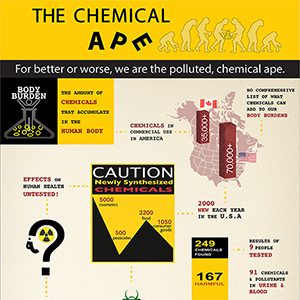Man The Chemical Ape is an infographic that depicts the amount of chemicals that accumulate in the human body.
Man: The Chemical Ape
For better or worse, we are the polluted, chemical ape.
Featured Programs
Body burden = the number of chemicals that accumulate in the human body.
We’re all polluted, but to what extent?
70,000+ chemicals in commercial use in America
35,000+ in Canada
With 2,000+ newly synthesized chemicals in the U.S. every year.
By type:
[type of product/number of chemicals]
Cosmetics:5000
Pesticides: 500
Food: 3,200
Consumer goods: 1,050
Except for food and drugs, how most of these chemicals affect human health is never tested.
Case Study:
9 people tested
Avg. of 91 chemicals and pollutants in blood and urine
167 chemicals total
76 caused cancer
94 are toxic to the brain or nervous system
79 cause birth defects or abnormal development
Our everyday exposure to chemicals
Case one: Salt
Pros: Sodium is necessary for life. Found in naturally occurring salt.
Cons: Table salt contributes to cellulite, rheumatism, arthritis, gout, and kidney/gall bladder problems.
Case two: cosmetics
Pros: Softer skin, brighter teeth, non-grey hair.
Cons: Can cause skin cancer, lymphoma, multiple myeloma, and birth defects.
Case three: Food Coloring
Cons: Can cause kidney, brain, bladder, testes, immune system, and adrenal tumors.
Pros: Good-looking cakes, processed foods, and meat.
Case four: Plastics
Pros:Enhance standard of living.
Cons: Potential presence of carcinogens, and interference with hormone function.
Case five: Receipts
Cons: Make you fat.
Pros: Help you keep track of purchases.
Salt
Table salt is dried at over 1,200 degrees Fahrenheit, changing its chemical structure.
This denatured sodium chloride takes exponentially more energy to digest, is lacking in nutrients, and causes health problems.
Cosmetics
Are rarely tested by the FDA. Instead, the CFTA (Cosmetic Toiletry and Fragrance Association) tests some of the potentially toxic chemicals.
Of 7,500 potentially toxic chemicals
Food Coloring
Blue#1 and 2, Citrus Red#2, Green #3, Red#3, and the most widely used Red#40 are all known to contribute to various cancers.
And are found in ALMOST EVERY PROCESSED FOOD.
Plastics
Most heated plastics, as well as pliable plastics, contain carcinogens.
Receipts
10 seconds of touching a receipt, or quickly crumpling the paper up, releases obesogens into your body. Enough receipts and you’re much likelier to be fat.
Many pollutants are impossible to escape, but over-exposure is avoidable. Keep an eye out for the chemicals on this list, and save yourself some trouble in the long run.
Related:

